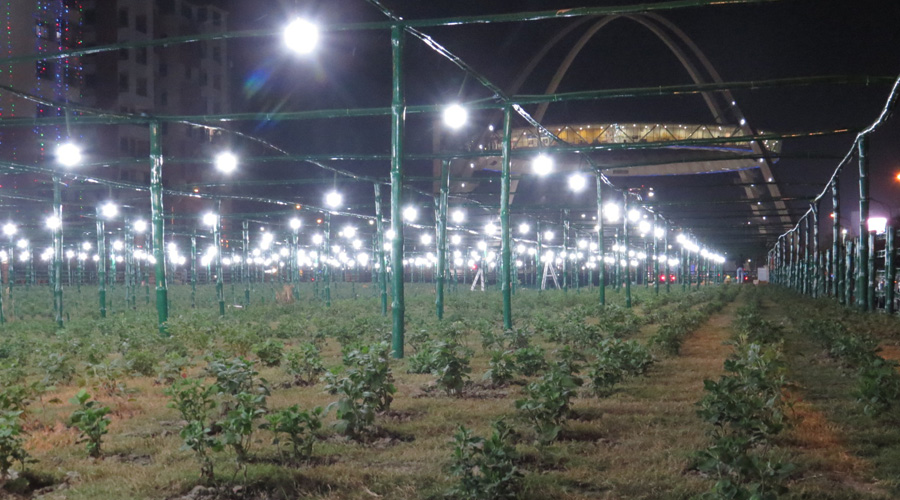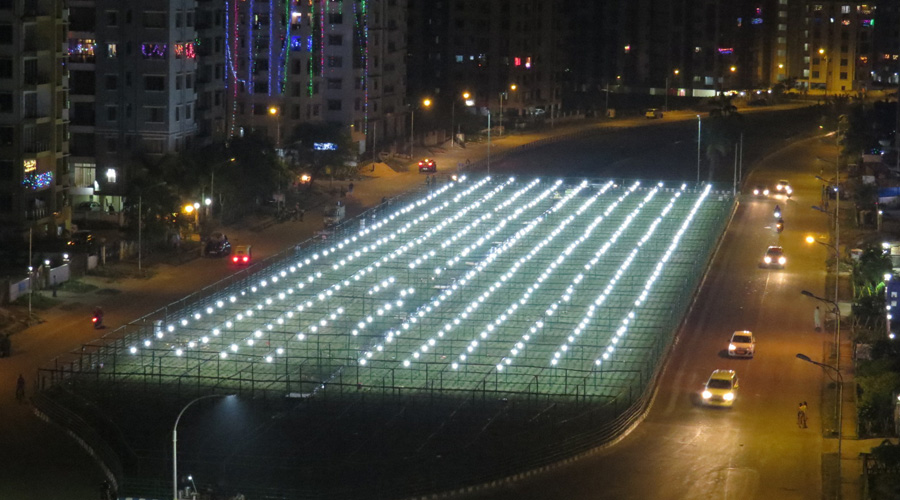If you are travelling by the Biswa Bangla Gate crossing towards Sector V in the evening, on looking leftward your eye would catch a luminous glow over the median of the road that goes towards Balaka Abasan. Come January and this is where chrysanthemums would bloom in a riot of colours.
The Housing Infrastructure Development Corporation (Hidco) is harvesting a two-acre stretch of the median divider with chrysanthemum and tuberose plants. The chrysanthemum bed has been lit up with LED lamps at a height of 2.5ft. “The lights will be turned on for the next 25 days from 6pm to 10pm. According to experts from the Bidhan Chandra Krishi Vishwavidyalaya (BCKV), this will boost their growth,” said Hidco chairman Debashis Sen, as he switched on the lights on Saturday evening, on the occasion of Diwali.
Explaining the grow-light technology, BCKV associate professor Tapas Kumar Chowdhuri said: “Chrysanthemum needs 14 hours of light for its growth. With daylight hours reduced in winter, photosynthesis is happening inadequately. This will mean less branches and less flowers. But if the hours can be increased with artificial lights, more photosynthesis will occur and the plant can produce enough nutrients. Chrysanthemum is a short-day plant, blossoming in winter. However, the ideal harvesting time is April-May when days are long. If planted at this time, a chrysanthemum cutting can produce more than 1,000 flowers in course of its life cycle. But if the harvest is done after September, this is a way to ensure proper growth.” After 25 days, the lights need to be switched off for the next 40 days to ensure reproductive growth, he added.

The illuminated bed of chrysanthemum plants after the LED lights were switched on Saturday evening. Picture by Sudeshna Banerjee
During this illuminated period, the stretch presents a great view, especially from atop the Biswa Bangla Gate. “This technology has been put to use by flower growers in Panskura. Tourists actually travel there during this period like they go to Japan in April to see cherry blossom,” said Sen. In Panskura, pollution and smog compel farmers to cover the plants for some hours during the day during their growth period and make up for the lost daylight hours by switching on lights at night.
NKDA has planted 12 varieties of chrysanthemum, numbering 50,000 cuttings, over one acre to produce a multi-colour bed. Once the season is over, summer varieties of flowers that are in demand commercially will be planted.
In the adjoining one acre, about 30,000 tuberose bulbs have been planted. “We will use a special strain of tuberose developed by BCKV that grows round the year,” Sen said.
The NKDA is looking to augment livelihood of villagers from adjoining areas. “We will provide the commercial linkage — where to get cuttings from, where to get cheap fertilisers from, how to protect the plants, how to take the crop to the wholesale markets… We will speak to nurseries and set up the forward and backward channels.”
The project will finally be handed over to local self-help groups. “We are speaking to the panchayat samiti to make the selection. We will provide the training,” Sen said.










